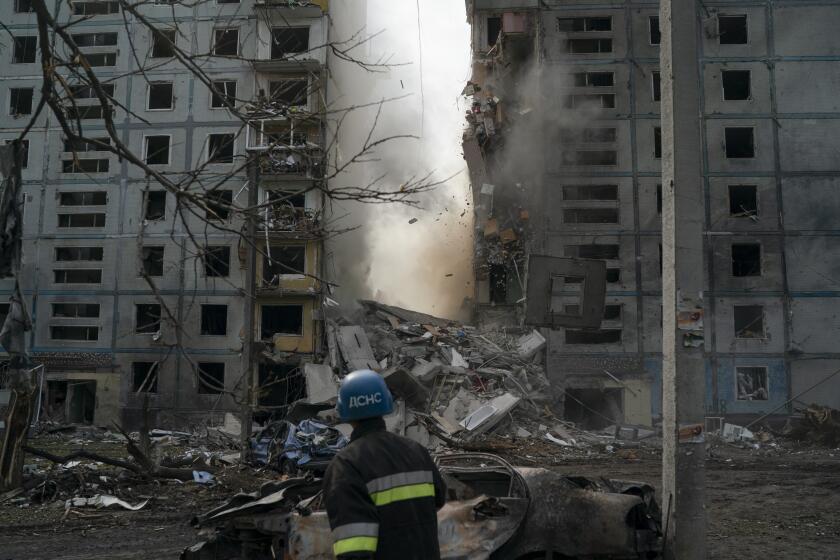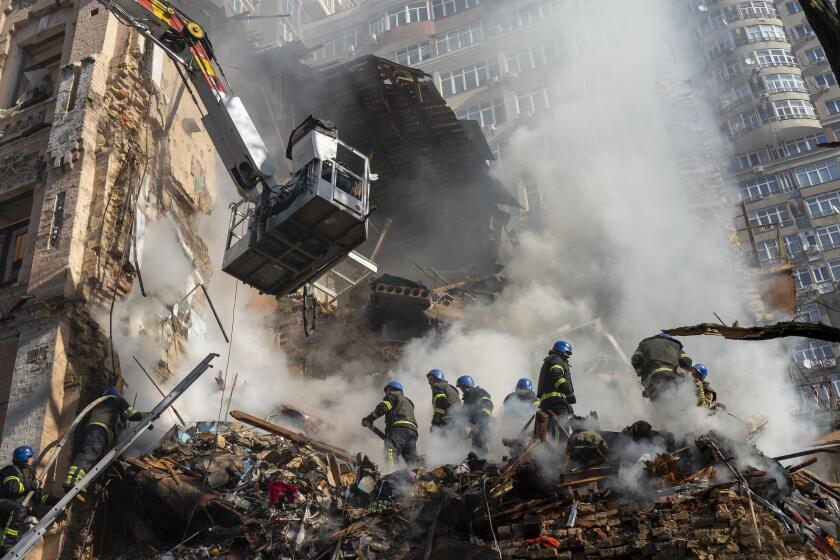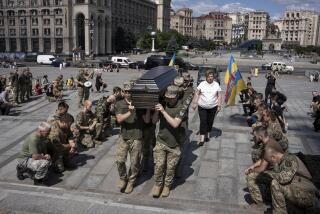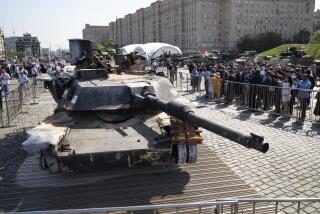Russian-installed authorities in Ukraine tell Kherson residents to leave ‘immediately’
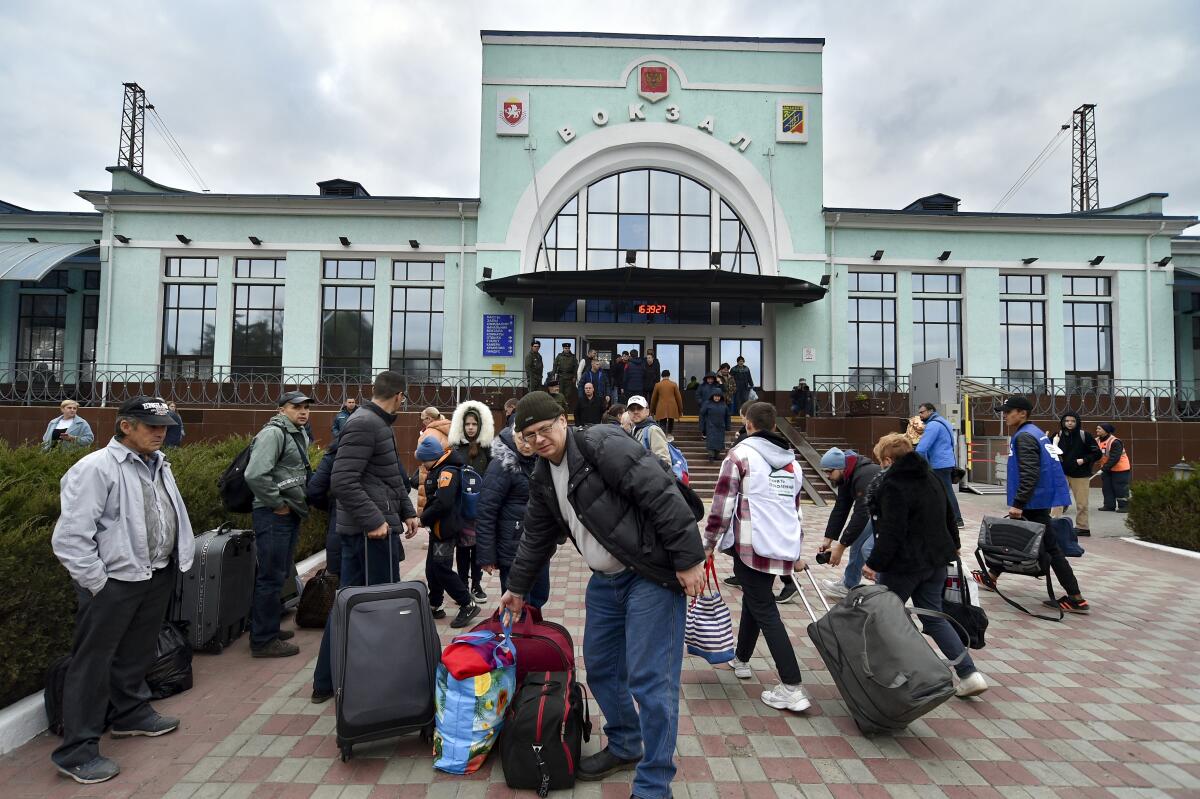
KYIV, Ukraine — Russian-installed authorities in Ukraine told all residents of the city of Kherson to leave “immediately” Saturday ahead of an expected advance by Ukrainian troops waging a counteroffensive to recapture one of the first urban areas Russia took after invading the country.
In a post on the Telegram messaging service, the pro-Kremlin regional administration called on civilians to use boat crossings over a major river to move deeper into Russian-held territory, citing a tense situation on the front and the threat of shelling and alleged “terror attacks” by Kyiv.
Kherson has been in Russian hands since the early days of the nearly 8-month-long war in Ukraine. The city is the capital of a region of the same name, one of four that Russian President Vladimir Putin illegally annexed last month and put under Russian martial law Wednesday.
On Friday, Ukrainian forces bombarded Russian positions across the province, targeting pro-Kremlin forces’ resupply routes across the Dnieper River and inching closer to making a full assault on Kherson city.
The Ukrainian military has reclaimed broad areas in the northern part of the region since launching a counteroffensive in late August. It reported new successes Saturday, saying that Russian troops were forced to retreat from the villages of Charivne and Chkalove in the Beryslav district.
Russian-installed officials were reported as trying desperately to turn Kherson city — a prime objective for both sides because of its key industries and ports — into a fortress while attempting to relocate tens of thousands of residents.
Russia has declared its intention to increase targeting of Ukraine’s power, water and other vital infrastructure in its latest phase of the invasion.
The Kremlin poured as many as 2,000 draftees into the surrounding region to replenish losses and strengthen front-line units, according to the Ukrainian army’s general staff.
The Dnieper River figures prominently in the regional battle because it serves multiple critical functions. It provides crossings for supplies, troops and civilians; drinking water for southern Ukraine and the illegally annexed Crimean peninsula; and power generation from a hydroelectric station.
Much of the area, including the power station and a canal feeding water to Crimea, is under Russian control.
Kherson’s Kremlin-backed authorities previously announced plans to evacuate all Russian-appointed officials and as many as 60,000 civilians across the river, in what local leader Vladimir Saldo said would be an “organized, gradual displacement.”
Another Russian-installed official estimated Saturday that about 25,000 people from across the region had made their way over the Dnieper. In a Telegram post, Kirill Stremousov reported that civilians were relocating willingly.
“People are actively moving because today the priority is life. We do not drag anyone anywhere,” he said.
Drones, allegedly Iranian-made, are in use by Russia in its war against Ukraine, the latest example of how the Kremlin’s war forces governments to contend with a Cold War-style calculus.
Ukrainian and Western officials have expressed concern about potential forced transfers of residents to Russia or Russian-occupied territory.
Ukrainian officials have urged Kherson residents to resist attempts to relocate them, with one local official alleging that Moscow wanted to take civilians hostage and use them as human shields.
Elsewhere in the invaded country, hundreds of thousands of people in central and western Ukraine woke up Saturday to power outages and periodic bursts of gunfire. In its latest war tactic, Russia has intensified strikes on power stations, water supply systems and other key infrastructure across the country.
Ukraine’s air force said in a statement Saturday that Russia had launched “a massive missile attack” targeting “critical infrastructure,” adding that it had downed 18 out of 33 cruise missiles launched from the air and sea.
European Union leaders have given the green light to a plan to provide Ukraine with about $18 billion in financial support over the next year.
Ukrainian President Volodymyr Zelensky later said that Russia launched 36 missiles, most of which were shot down.
“Those treacherous blows on critically important facilities are characteristic tactics of terrorists,” Zelensky said. “The world can and must stop this terror.”
Air raid sirens blared across Ukraine twice by early afternoon, sending residents scurrying into shelters as Ukrainian air defense tried to shoot down explosive drones and incoming missiles.
“Several rockets” targeting Ukraine’s capital were shot down Saturday morning, Kyiv Mayor Vitali Klitschko said on the Telegram messaging service.
The president’s office said in its morning update that five drones were downed in the central Cherkasy region southeast of Kyiv.
The governors of six western and central provinces, as well as of the southern Odesa region on the Black Sea, gave similar reports.
Ukraine’s top diplomat said the day’s attacks proved Ukraine needed new Western-reinforced air defense systems “without a minute of delay.”
“Air defense saves lives,” Foreign Minister Dmytro Kuleba wrote on Twitter.
Kyrylo Tymoshenko, the deputy head of Ukraine’s presidential office, said on Telegram that almost 1.4 million households lost power as a result of the strikes. He said some 672,000 homes in the western Khmelnytskyi region were affected and an additional 242,000 suffered outages in the Cherkasy region.
Most of the western city of Khmelnytskyi, which straddles the Bug River and had a prewar population of 275,000, was left with no electricity, shortly after local media reported several loud explosions.
In a social media post Saturday, the City Council urged residents to store water “in case it’s also gone within an hour.”
The mayor of Lutsk, a city of 215,000 in far western Ukraine, made a similar appeal Saturday. Power in Lutsk was partially knocked out after Russian missiles slammed into energy facilities, Mayor Ihor Polishchuk said.
He later added that a civilian suffered burns when a shockwave from the strike hit his house, and that one power station had been damaged beyond repair.
The central city of Uman, a key pilgrimage center for Hasidic Jews with about 100,000 residents before the war, also was plunged into darkness after a rocket hit a nearby power station, regional authorities said on Telegram.
Ukraine’s state energy company, Ukrenergo, responded to the strikes by announcing that rolling blackouts would be imposed in Kyiv and 10 Ukrainian regions to stabilize the situation.
In a Facebook post Saturday, the company accused Russia of attacking “energy facilities within the principal networks of the western regions of Ukraine.” It claimed the scale of destruction was comparable to the fallout earlier this month from Moscow’s first coordinated attack on the Ukrainian energy grid.
Both Ukrenergo and officials in Kyiv have urged Ukrainians to conserve energy. Earlier this week, Zelensky called on consumers to curb their power use between 7 and 11 a.m. and to avoid using energy-guzzling appliances such as electric heaters.
Zelensky said earlier in the week that 30% of Ukraine’s power stations have been destroyed since Russia launched the first wave of targeted infrastructure strikes Oct. 10.
In a separate development, Russian officials said a shelling attack on a frontier town just miles north of the Ukrainian border killed two people and wounded 12.
Andrey Ikonnikov, the health minister for the southern Belgorod region of Russia, said a 14-year-old boy and an older man died on the spot after shells hit civilian infrastructure in Shebekino, which is home to about 44,500 people.
Earlier social media posts by the regional governor, Vladislav Gladkov, blamed the attack on Ukraine. Russia has previously accused Ukrainian forces of numerous strikes on civilians in the border regions of Belgorod and Kursk. Kyiv has not formally responded to these accusations.
Kozlowska reported from London.
More to Read
Sign up for Essential California
The most important California stories and recommendations in your inbox every morning.
You may occasionally receive promotional content from the Los Angeles Times.
